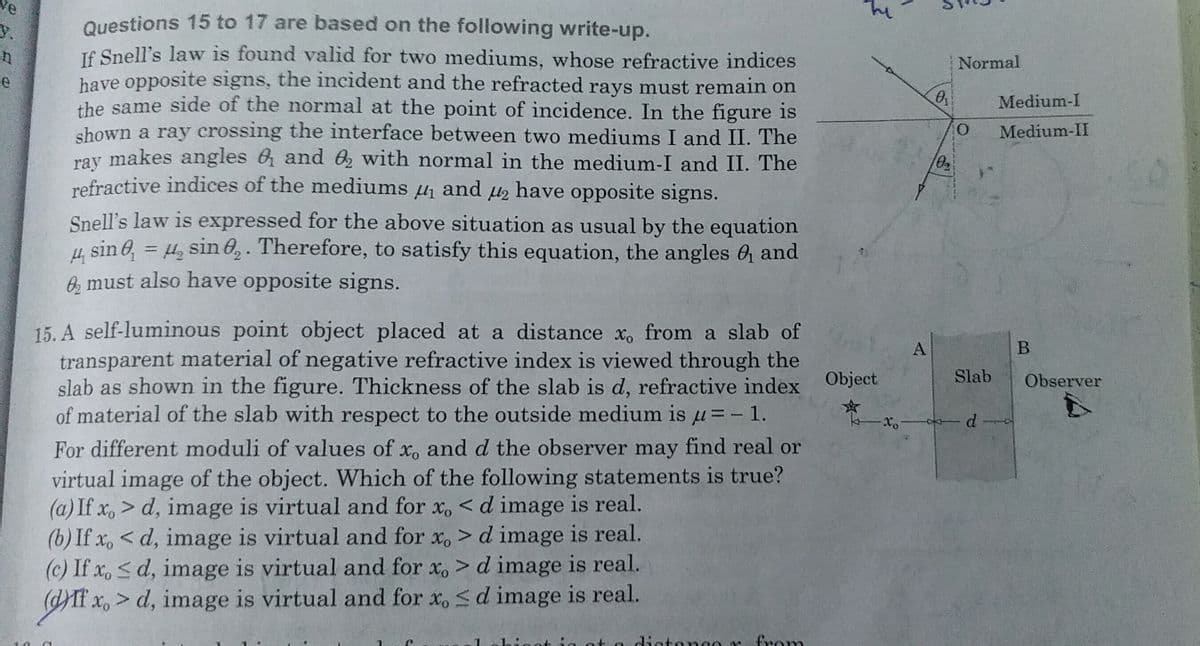15. A self-luminous point object placed at a distance x, from a slab of transparent material of negative refractive index is viewed through the slab as shown in the figure. Thickness of the slab is d, refractive index of material of the slab with respect to the outside medium is u= - 1. For different moduli of values of x, and d the observer may find real or virtual image of the object. Which of the following statements is true? (a) If x, > d, image is virtual and for x, < d image is real.
15. A self-luminous point object placed at a distance x, from a slab of transparent material of negative refractive index is viewed through the slab as shown in the figure. Thickness of the slab is d, refractive index of material of the slab with respect to the outside medium is u= - 1. For different moduli of values of x, and d the observer may find real or virtual image of the object. Which of the following statements is true? (a) If x, > d, image is virtual and for x, < d image is real.
Physics for Scientists and Engineers: Foundations and Connections
1st Edition
ISBN:9781133939146
Author:Katz, Debora M.
Publisher:Katz, Debora M.
Chapter38: Refraction And Images Formed By Refraction
Section: Chapter Questions
Problem 126PQ
Related questions
Question
Answer is also mentioned in picture containing the question. Kindly check the answer before submitting The solution. Wrong solutions have been posted for this question multiple times in past. Kindly do not refer to old solutions posted for this question. Do not put values in expression provided in answer and submit solution.

Transcribed Image Text:ve
The
Questions 15 to 17 are based on the following write-up.
If Snell's law is found valid for two mediums, whose refractive indices
have opposite signs, the incident and the refracted rays must remain on
the same side of the normal at the point of incidence. In the figure is
shown a ray crossing the interface between two mediums I and II. The
ray makes angles 6 and 02 with normal in the medium-I and II. The
refractive indices of the mediums µ and u2 have opposite signs.
Normal
Medium-I
Medium-II
Snell's law is expressed for the above situation as usual by the equation
H sin 6, = 4, sin0,. Therefore, to satisfy this equation, the angles & and
6, must also have opposite signs.
%3D
15. A self-luminous point object placed at a distance x, from a slab of
transparent material of negative refractive index is viewed through the
slab as shown in the figure. Thickness of the slab is d, refractive index Object
of material of the slab with respect to the outside medium is u= - 1.
A
B
Slab
Observer
d
For different moduli of values of x, and d the observer may find real or
virtual image of the object. Which of the following statements is true?
(a) If x, > d, image is virtual and for x, <d image is real.
(b) If x, < d, image is virtual and for x, > d image is real.
(c) If x, < d, image is virtual and for x, > d image is real.
X, > d, image is virtual and for x, <d image is real.
n ot o distance from
Expert Solution
This question has been solved!
Explore an expertly crafted, step-by-step solution for a thorough understanding of key concepts.
This is a popular solution!
Trending now
This is a popular solution!
Step by step
Solved in 2 steps with 3 images

Knowledge Booster
Learn more about
Need a deep-dive on the concept behind this application? Look no further. Learn more about this topic, physics and related others by exploring similar questions and additional content below.Recommended textbooks for you

Physics for Scientists and Engineers: Foundations…
Physics
ISBN:
9781133939146
Author:
Katz, Debora M.
Publisher:
Cengage Learning

Principles of Physics: A Calculus-Based Text
Physics
ISBN:
9781133104261
Author:
Raymond A. Serway, John W. Jewett
Publisher:
Cengage Learning

University Physics Volume 3
Physics
ISBN:
9781938168185
Author:
William Moebs, Jeff Sanny
Publisher:
OpenStax

Physics for Scientists and Engineers: Foundations…
Physics
ISBN:
9781133939146
Author:
Katz, Debora M.
Publisher:
Cengage Learning

Principles of Physics: A Calculus-Based Text
Physics
ISBN:
9781133104261
Author:
Raymond A. Serway, John W. Jewett
Publisher:
Cengage Learning

University Physics Volume 3
Physics
ISBN:
9781938168185
Author:
William Moebs, Jeff Sanny
Publisher:
OpenStax

An Introduction to Physical Science
Physics
ISBN:
9781305079137
Author:
James Shipman, Jerry D. Wilson, Charles A. Higgins, Omar Torres
Publisher:
Cengage Learning